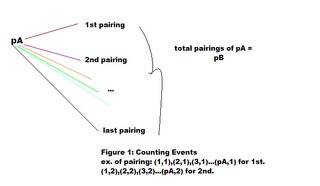Let

Formula:

Proof:
We are dealing with two events.
Probability means total expected(desired) outcomes over total outcomes.
only expected outcomes -----------> pA(1st) pB(2nd)
total outcomes --------------------->qA(1st) qB(2nd)
Count them up!

(Enlarge diagram by clicking it)
Figure 1 reflects the well-taught Counting Principle, which just means to multiply for deducting totals.
All possible pA and pB events = pA [1st pairing] + pA [2nd pairing] + ... pA [last pairing] =
( pB [total pairings] )( pA) = pA * pB
Similarly,
Total outcomes = qA * qB
This proves P(A and B) = (pA *pB) / (qA * qB).
Quick Discussion:
Common misconception is to add two independent events, but you can't because they are separate.
Ex. Let P(A) = 9/10 and P(B) = 3/10. Adding gives you 6/5. The numerator cannot go over the denominator.
Total probability never exceeds one!

No comments:
Post a Comment